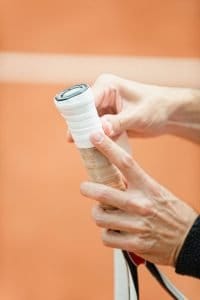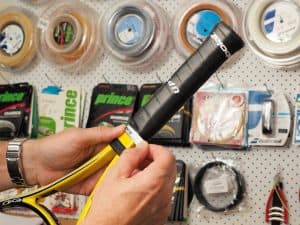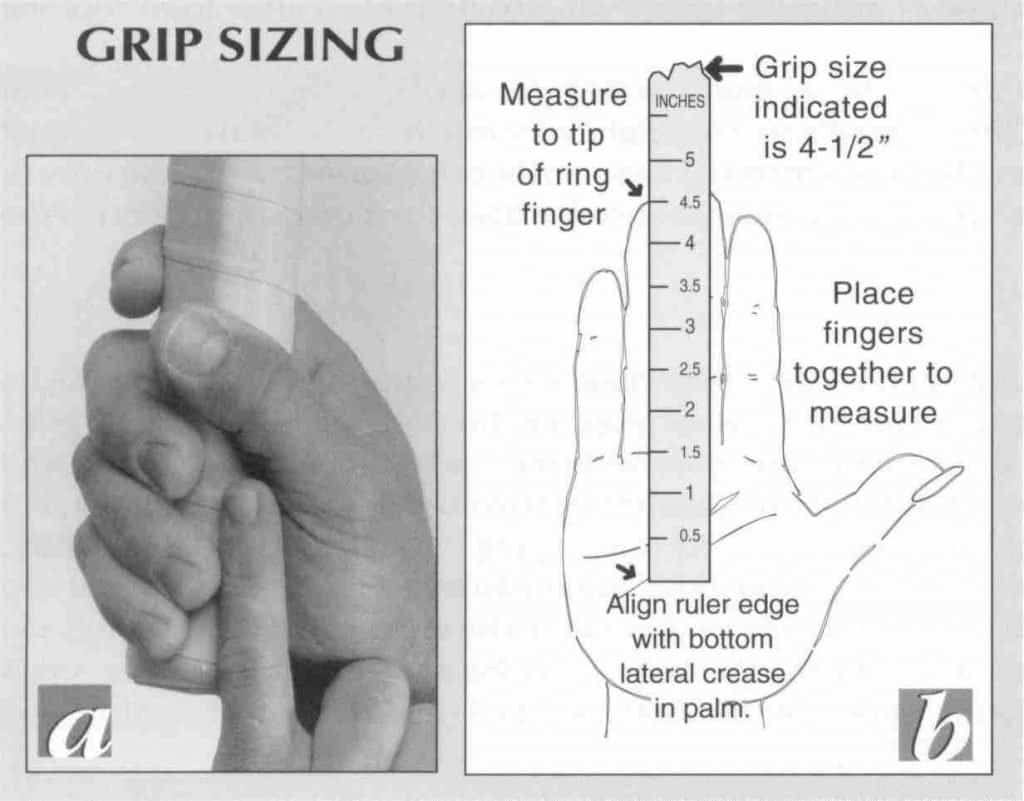Not too often do we hear about tennis players and coaching talking about the original grip of the racket. We can discuss overgrips all day long, but when it comes to the original grip, the one that comes with the racket, there’s not much that anyone has offered in terms of information.
Some players actually prefer to replace a regular grip rather than put on an overgrip because of the type of feeling you get from being closer to the handle. There are several grips on the market, and they do offer something different each time.
It’s important to go over things like regripping an original grip because it’s actually more difficult than replacing an overgrip due to its thickness and more sturdy structure.
Let’s talk about the things to consider when purchasing new original grips and the best grips for 2022. Note that many tennis websites will refer to these grips as replacement grips.
Table of Contents
In a Hurry? Here’s Our Top Picks…
| Image | Title | Buy |
|---|---|---|
 | Gamma Hi-Tech Gel Contour Replacement Grip | Buy Now |
 | HEAD Hydrosorb Tour Tennis Racket Replacement Grip | Buy Now |
Top | Wilson Classic Contour Replacement Tennis Racket Grip | Buy Now |
 | Dunlop Leather Pro Grip | Buy Now |
 | Tourna Leather Grip | Buy Now |
 | WILSON Micro-Dry Comfort Replacement Grip | Buy Now |
 | Tourna Pro Thin Tennis Replacement Grip | Buy Now |
Why Choose a Replacement Grip
Why do some people prefer to use a replacement grip rather than doing an overgrip on the racket? Well, it depends on many preferences that a player has due to things like how much they sweat and how they hit the ball.
The truth is that it’s a varying answer but the top three reasons are listed below.
- Consistent Size
- Closer Feel To The Handle
- Option Preferences
Let’s break down each category to really understand why replacement grips may be a better fit for you than overgrips.
Consistent Size
If you are using the same replacement grip over and over again, then you can feel comfortable knowing that the racket handle will feel the exact same size every time. It’s common for more frequent players to break strings and then pick up the next racket to feel like the racket handle size has gotten a little larger or a little smaller.
Sometimes then can really throw off a player and the overall feel of the racket. It changes the grip of the hand on the racket slightly and can be frustrating. This is largely due to when a player places an overgrip on the racket, it’s hard to gauge how much stretch they put on the grip every time.
This will cause some rackets to be thicker with too much overlap or some grips to feel really thin when they are pulled too much.
Another thing that happens with overgrips that doesn’t really happen with replacement grips is moldability. The cushioning in an overgrip will be so soft that you have to place the hand on the racket so many times, the grip will start to squish or indent. This can provide an inconsistent feel as well.
Market Preferences
Sometimes you find something you like as a player and just want to stick with it. That can be the case with replacement grips. While they can offer the same types of qualities and benefits and overgrip will, they also offer different products.
Tennis is all about preference of racket and product, and this can sway a user in one diffraction over another.
It’s also good to note that we may think we have personal preferences for something, but it’s always a great idea to try something that is out of your comfort zone. We can be completely surprised and love something that we thought we would hate.
This is pretty close to the same method that goes into trying a racket out. Sort of like demoing.
Qualities For A Replacement Grip
Many of the qualities you want to look for in a replacement grip will be some of the same qualities you will look for in an overgrip. However, there are some notable differences. Another thing to consider is that replacement grips are that the one that comes with your racket will likely be of poor quality.
Most manufactures don’t think you’ll be using that, so they don’t put a high-quality one on.
- Thickness
- Texture
- Durability
- Stickiness
- Absorption
Thickness
Replacement grips are always going to be thicker than an overgrip. It may not feel that way once it’s placed on a racket, but if you were to remove the replacement grip and put on an overgrip, you would feel uncomfortable.
Synthetic grips tend to range from 1.19 to 2.10 millimeters, while leather grips range from 1.42 to 1,50 millimeters. The thicker a replacement grip is, the more cushion and comforts you can expect to your hands and arms.
Texture
A lot of these grips will offer a smoother feel, especially if you go in the direction of choosing a leather grip. This is more old school, and there are fewer options when choosing the leather grip. However, when going synthetic, you can have more choices like ribbed or something that is less smooth to increase traction between the grip of the racket and the player’s hand.
This helps and causing the racket to stay steady, but can also impact the hand as it can be rougher.
Durability
These grips are more expensive per unit than an overgrip, and you definitely want something that is going to be more durable. However, the more frequent players may find that they don’t last as long as they want. When a grip starts to show rips and tears and break down, it is usually a good indicator to consider regripping your replacement grip.
One of the most durable replacement grips that you can buy is 100 percent leather-made grips. Think of your leather chair or couch in your house and how indestructible that thing is. This is the same leather you would be putting on your racket.
Stickiness
Having some tackiness to your grips is important. Just like overgrips, replacement grips will offer several levels of stickiness and tackiness. For players that sweat more, they made need something more sticky to hold the racket better when performing.
Sometimes a racket can be too tacky and really cause some damage to the hands or just make it difficult for a player to move the racket. If you like the feeling of a tacky grip but sometimes struggle with the above-mentioned, you can combine this type of grip with some chalk in your hands, and it will feel much better.
Absorption
Absorption can be described in a similar manner to stickiness. The thicker a grip is, the better chance they have for absorption, and several grips will offer this to a player. Those who have sweaty hands and are in warmer climates will need a better absorption rate than others.
Some grips will deal with sweat absorption by perforating the grip and putting tiny holes in it to make it more breathable and hold less moisture. While these are generally thicker grips, there are a few different options on the market that is both a thin grip and perform well in dealing with your sweaty palms.
Top Grips To Choose From
So how do we go about this? What are the options? These are the top options for your to choose from when it comes to selecting a replacement grip. Each of them offers something slightly different to meet standards for different preferences.
Even based on these descriptions, it’s not a bad idea to try some of these out for yourself to figure out what really works and what doesn’t.
1. Wilson Cushion Aire Classic Contour Grip
This Wilson Cushion Aire Classic Contour Grip is a grip that prioritizes texture and feel for its players. The contour part comes from having a ridge to add stability and prevent the racket from turning over in your hand.
This can be ideal because it helps keep the grip longer, as a smooth grip can quickly lose its tackiness. The grip itself is 1.80 millimeters, and thickness leaving it on the thicker side of replacement grips. This is largely due to its extra cushion in an attempt to provide comfort from the handle to the hand. ‘
- Raised edge on grip
- Enhanced feel
- Available in black
This grip also offers a great stick and absorption rate of sweat, making it really easy for players to feel like they have good control.
2. HEAD Hydrosorb Tour Replacement Grip
The HEAD Hydrosorb Tour Replacement grip comes at a more affordable price than some of its competitors. Priced at around $8, this grip is known for its comfort and moisture handling capabilities.
The grip itself has tiny holes that are a part of its ventilation system so that sweat can be absorbed and filtered out properly. The tour, as opposed to the pro, offers a little less cushion but a much better feel as it lays flat great, giving players more connectedness to the racket.
- HEAD PERFORMANCE: Born out of revolutionizing how we ski and play tennis, HEAD has constantly pushed athletic equipment into the modern era. With decades of experience in all racquet sports; HEAD offers nothing but the best tennis equipment on the market.
- ENHANCED GRIP: Made from a specially engineered tacky elastomer material, HEAD tennis racquet replacement grips offer added grip for more control with every shot.
- MOISTURE ABSORBING: Hold tight through the most intense rallies with a tennis racket grip that absorbs excess moisture. Dry hands means more precision when you need it most.
- SUPERIOR FEEL: The racquet grip tape is an ideal upgrade for your racquets worn stock handle. Remember, youre only as good as your equipment!
- PREMIUM ELASTOMER: Hydrosorb Tour gives perfect racket feel while providing enough of a comfortable cushion on your han
Overall it’s a great balance and supplies enough tackiness to the grip without making a player feel like the racket is stuck to their hand.
3. Gamma Hi-Tech Contour Grip
The Hi-Tech tennis grip by Gamma is one of our favorites and comes as one of the most highly praised products on the market. What we based our decision on is the fact that it comes with a Contour design which is an ideal choice if you have sweaty hands or are just starting. Its highlight point is the superb tuck that goes a long way in terms of grip traction and allows you to have more control over the racquet.
Not only that but Hi-Tech did a fantastic job manufacturing a replacement grip that offers enhanced breathability and that will prevent/minimize moisture issues common for tennis grips. In addition to that, we found that it offers a cushioned variant which is an even greater choice if you want to avoid blisters.
- Leading edge equipment
- Help you rule the court
- Maximum durability for hours of play
Another design detail that makes this product such a great choice is the Zorbicon gel which is responsible for allowing industry-standard control and combines with the advantages of Contour design to offer an irreplaceable product. In addition to that, this product is pretty simple to get play with much like other popular tennis grips that you’ve been playing with.
The superb breathability and the fact that it is available in a cushioned variant to make this product a choice that you should consider as a beginner, intermediate as well as a professional player getting into the tournaments. Yes, it does come at a tack higher price but its design and
4. Dunlop Leather Pro Grip
Now the Dunlop Leather Pro Grip comes at a price. You can feel like you’re back in the McEnroe era playing alongside Connors and Lendl. This 100 percent leather grip offers a classic feel that simply just can’t be replicated.
The leather offers unparallel durability, which explains the high price point. The thickness of this will offer a sturdy grip.
- PREMIUM LEATHER GRIP: Provides excellent sensation and unmatched accuracy of feel
- EXCELLENT GRIPPING POWER: 1. 5MM Grip with tacky feel
5. Tourna Leather Grip
For a leather grip that is slightly cheaper, you can turn to the Tourna Leather Grip. This comes at a price of around $13 and is a favorite among leather grip users for its supreme quality. Tourna itself rates high in grips for tennis as they devote most of their energy towards grips.
Part of the reason that it is such a popular grip among leather users is that it is designed in mind with the racket handle and incorporates beveled edges to prevent an unclean wrapping.
- Adhesive backing for quick installation
- Beveled edges for a perfect fit
- Genunie Leather
- From the makers of Tourna Grip
- Size: 1 x
6. Wilson Micro Dry Comfort Grip
This is made for those who sweat a lot. It can be frustrating to constantly have to replace original grips if you sweat a lot and you feel them getting wet and never drying the way you want.
That’s why the Wilson Micro Dry Comfort Grip entered the scene. Its thickness is one of the thicker ones on the market, with a 2.20 millimeter dimension. This grip has a perforation system that helps absorb a larger amount of sweat while also giving you a padded and cushion feel.
The soft surface of the grip will make your hands feel at home. This grip sells for around $10. It only comes in black.
- Thick Foam Backing
- Great For Added Softness
- Available In Black
7. Tourna Pro Thin
Those who need something a little thinner because it’s difficult for their hands to wrap around the handle or because they prefer a closer feel to the handle will ike Tourna Pro Thin. It is 1.25 millimeters thick, making it our thinnest option on the list. It’s meant to reduce your grip size of the racket by one full notch. So if you are originally handling a 2 grip size, this replacement grip will bring it down to a 1. This is great for those who feel like they made a mistake in choosing the original grip size.
It has other great qualities as well. It has a perforated grip meaning the sweat absorption actually is pretty good despite how thin it is. However, people need to consider that because it is so thin and has a perforated system, you can feel the bevels of the racket. This may be really uncomfortable for some people.
The grip itself is tacky and can handle humid conditions for quite some time.
- Tourna Pro Thin is 1.25mm thin for the ultimate true feel.
- Reduces your grip size by 1
- Perforated over the entire surface to help absorb moisture
- Backed with adhesive for a secure skin tight wrap around the handle
- Beveled edges ensure a seamless skin tight wrap around the handle
- Long enough for the largest tennis handles
- 1 Grip per Package, includes Finishing T
How Do I Grip-It?
Well, this is a little more complicated than an overgrip. Even if you are a seasoned tennis racket gripper, putting an original or replacement grip on it can be quite challenging. It requires a few more tools and some patience because you really need to lay the grip flat down to match with the bevels.
Sounds easy but remember the grips are a lot thicker and are not flexible enough to pull tight. It really is a process. Follow these guided steps carefully for the best results.
Note that a lot of these replacement grips will come with adhesive backing, but if for some reason they don’t, then you will need double-sided tape to hold the grip to the handle of the racket.
- First, you will need to take the original replacement grip off the racket by removing the tape at the top holding it in place. This will expose the actual handle of the racket and the edges/bevels.
Once you remove the tape, start to unravel the grip and completely remove the racket handle. You can discard this as you won’t be using either the grip or the tape again.
- Sometimes there is a staple at the end of the grip that is keeping it in place. This is usually right at the butt cap, and if you find this, please remove it. This won’t be something you can rip off with your hands. You’ll need to grab a pair of pliers, a screwdriver, or a flat heat to remove the staple from the butt cap.
- Now you can open your replacement grip. There will be two kinds of protective plastic that you will need to remove once you have the grip out of the packaging. The first will be the small thin layer of plastic wrap covering the side your hand will have contact with while playing. This is protecting the stickiness of the grip like it does for an overgrip.
- The second part is the backing to the side that will lay on the handle. This will be thick, and it’s important that once you start to take the backing off, you don’t let that side touch things and lose its stickiness. You can also take off a little by little, which makes the process a little easier. The sticky side needs to be reserved for the handle only.
- Right-handed people will hold the racket in their left and grip the racket from left to right while twisting the racket around and laying the grip down. The left-handed people will do the exact opposite pattern going from right to left.
- Now you need to align the skinnier end with one of the flat edges of the surfaces. You will be holding the racket upside with your non-dominant hand. It’s important that once you start to wrap the grip around the racket that you apply a lot of tension and pressure to ensure that it’s laying down smoothly and flat with no bumps.
- Your right hand should be taking the grip between your thumb and pointer finger while keeping your left thumb pressed down on the grip that is beginning to lay flat. Now you will rotate the racket inward with your left hand, keeping your left thumb down on the part of the grip that starts to fall onto the handle. If you start to get creases and bubbles, this is no good and will be difficult to re-do too many times.

- Go slow because if you have to start over and over, you will lose the tackiness. You will want to keep tight tension with your right hand on the grip as your press the grip down on the handle with your left thumb and hand. You will move the grip down slightly with each turn creating a diagonal slope so that the grip only overlaps slightly with the previous wrap around the racket. This should be the natural path of the grip and easy to follow in general.
- You will continue this pattern all the way till you have reached the top (or, in this case, the bottom) of the handle, and all the handle is covered. Now you should use a pen or something where you can mark the part of the grip where it just meets the racket’s throat. You will have some excess grip and should cut the grip at a diagonal, so it fits perfectly with the frame. Sometimes a manufacturer will already have done this for you, and the length fits perfectly.
- Now you can secure the grip with the tape at the top. It’s important to stick down well as you don’t want the grip to slip and unravel. Of course, before doing this, make sure your grip is laying down flat on the racket and overlapped at the right length. There should be no bubbles or any bad creases.

This is how you grip a racket however, there are some things you should note to ensure you did it correctly.
What Are The Grip Handle Sizes and How Do I Choose?
Racket handles come in sizes 0-6 but most commonly 1-4 or 4 ¼, 4 ⅜, 4 ½, and 4 ⅝. The best way to really know is to play with a few different sizes first. It’s possible that when your hand is getting tired quickly, your grip size is too big. As mentioned, thin grips can assist with this issue, but it’s better to try and figure out the problem before ordering new rackets.
There are a couple of tennis tricks like the ruler test that can help solve this issue. However, this is sometimes for players who are used to playing with an overgrip. Confirm your results by testing out the handle size.
Step 1: Place all fingers tightly together like you are telling someone to stop.
Step 2: Place a ruler to the horizontal crease all the way up to the tip of your ring finger.
Step 3: This is the size that you should play with.
Or you can use the finger test. Hold the racket like you would for hitting a forehand. A finger from your opposite hand should be able to squeeze in and fit snuggly from the tips of your fingers on the racket to your palm.

You can always customize the racket size by playing around with the level of thickness of an overgrip, as mentioned above. However, it is ideal to take the time to follow the above steps because it can be a little bit of a process to play with the overgrip and its level of stretch.
Help I Sweat A lot. What Do I Do?
These grips can get expensive, especially for the players who are playing every day and are sweating a ton. Even if you don’t have sweaty palms, the sweat drips from your arms to your hands and can really get a grip to deteriorate a lot quicker. That’s why you will see many pros with a bunch of didn’t tools and tips and tricks up their sleeve to combat sweatiness.
Here are some things to consider.
A Towel
Anytime we watch tennis on TV, we see the ball girl and boy offering a player’s towel to them constantly. Bringing a towel on the court is a great way to wipe of the sweat from your hands and body before letting it soak through your grip. There are also a number of towels that offer a tacky feel that sometimes can make your hands feel sticky right after using them.
Sometimes players will even have two towels in the hottest conditions. This is because the first towel soaks through, and then you are left with no alternative.
Powder
Using a powder or chalk that we commonly see powerlifters and baseball players use is a great idea because we use them for the same reasons. Not only do they provide a dry feel, but they offer a better grip to the racket as well. They can also be super helpful in preventing blisters and wet skin from ripping because of their ability to keep an overly tacky grip from rubbing too hard against the hands.
While there are so many great powders to choose from, you will likely find some popular ones in any sporting good store. What tennis players are fond of but are somewhat of a secret is the powder bag you may see a pitcher put in his pocket or on the ground near him. This is because it’s easier to hit your hands with a powder bag than it is to put your hands in a container of powder.
Liquid Solutions
Some of the chalk and powder options first can come in a liquid bottle and turn chalky or remain sticky to offer extra tackiness to a grip. You can use this in combination with a dry grip or add on extra tack by pairing it with already quite a sticky grip. This would be ideal for most extreme conditions with high humidity.
Wilson and Tourna both have a gel solution that works great. They come in small bottles, and you can just squeeze the bottle to put a dime size amount in your hands. When you rub the gel in your hands, it should start to turn into a chalky powder.
Blister Padding
For those who need more comfort or already suffer from blisters, there are many bandaids and hand padding options that fit comfortably with racket handles. Finger socks, in particular, are great for those who develop blisters on their fingers. Some players like to use a soft tape, and this is a solution as well.
Somewhere as simple as a sporting goods store or even a CVS, Walgreens, etc., will offer these kinds of bandaids and tapes that are meant to stay on even with a lot of sweat.
Sometimes, if a trainer or someone works with athletes around, they can wrap it for you in the right way. If not, there are a number of YouTube videos demonstrating the best ways to wrap a blister to ensure the wrapping doesn’t fall down and so you can move as free as possible.
Conclusion
There is nothing more important than feeling connected to your racket. We all have personal preferences as tennis players as to what that feeling is actually like. Some people will prefer one thing that might completely blow the mind of another player. It’s a minor thing to take care of, picking out a grip, but the role it plays in our games is absolutely massive.
As discussed, a replacement grip can have so many different variables like thickness, durability, tackiness, and more that will determine the feel a player will get from holding the racket. For the most part, a thinner grip will provide a closer feel to the handle and not do as well with sweat absorption as some of the other rackets. However, as listed, a few have an all-around ability to perform well in different categories.
With the ability to determine what makes a grip up and our recommended list of replacement grips, you are sure to find something you like. As with many things, it takes a little bit of trial and error, but once you find your match, you will be hitting happy!












